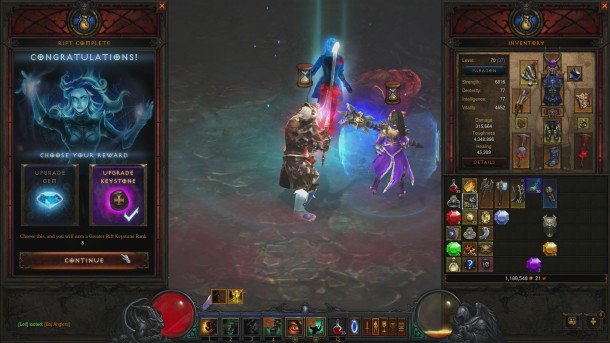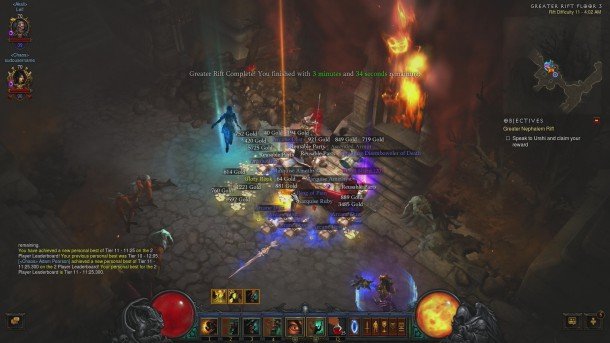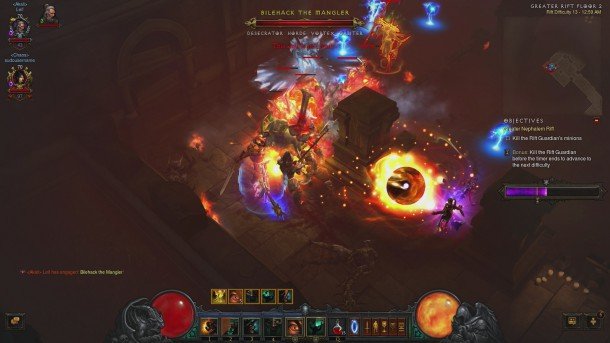Diablo 3 patch 2.1 emphasizes speeding through content, and that's a good thing

Diablo 3 normally isn't a particularly rushed game. The end of the world may be at hand, but it's typically content to let you slice through the minions of Hell at your own pace, comparing loot and weighing stats as you go. That all changes with patch 2.1, which went live at the end of August . Both the new Greater Rifts and Seasons place an emphasis on speed, whether it's in beating timed rifts for a chance at better loot or by competing against other players to reach the level cap anew (and pile up new weapons and transmog items in the process). Combine all that with powerful new legendary gems, and the result is a patch that injects Diablo 3 with a powerful shot of adrenaline.
The Greater Rifts are the stars of Blizzard's latest show. The keystones that trigger them drop from the final bosses of the randomized Nephalem Rifts introduced with the Reaper of Souls expansion , and the new versions grant access to rifts where loot only drops from the big guy at the end rather than the rabble of commonplace demons. The bar that triggers the Rift Guardians by slaying enemies remains, but in the Greater Rifts it's accompanied by an hourglass that continually compels you to progress ahead of it. Beat it, and the boss explodes in a shower of legendaries, crafting components, and gems that usually makes up for the absence of loot prior to the fight. More importantly, you're given a chance to upgrade your riftstone to unlock an even tougher Greater Rift.
The added speed and the promise of tougher challenges and better loot manages to make the game even more addicting than before. It also adds meaning to formerly mundane aspects of the level design. A friend and I discover this while we're minutes ahead of the timer and trying to convince ourselves that the Greater Rifts are perhaps too easy. We fling spells with abandon, we swing axes with conviction. And, well, we hit into a dead end and run out of enemies.
This sometimes happens in the game proper, but now we're sweating as we pass what feels like empty miles of ground we've already traversed, all while the hourglass inches up like a tortoise to our hare. In time, we find the right trail and managed to down the rift boss seconds away from failure. We were grateful for the tension after the fact, and I suspect I'll remember that moment more than I remember the entire campaign storyline years from now.

Why endure such tribulation? High placement on the accompanying speed leaderboards may be reward enough for some, but the final bosses of Greater Rifts also drop legendary gems that make the hassle and hustle worthwhile for everyone else. And they live up to the majesty of their names. Rift after rift, my friend and I gawp at new gems that might, say, poison enemies hit for 2000 percent weapon damage over 10 seconds. Still another might make primary skills 25 percent more effective. The variations are myriad and diverse, but Blizzard keeps their effectiveness in check by limiting their placement to socketed rings and amulets. These, frankly, are about as common as snow in South Texas, and their scarcity makes the choice of which gem you should socket that much more meaningful.
According to Blizzard, a new map called the Cesspools sometimes pops up in the rifts, but on personal evidence alone, I'm tempted to say it's about as real as an October release date for Half Life 3. I plunked 27 normal Nephalem Rift keystones into the obelisk over a weekend, and I saw it exactly never. A shame, really. Bugs and design flaws kept the map from the Reaper of Souls release, and lingering issues with checkpoints led to its temporary removal from Greater Rifts a couple of days ago.
Legend (i.e. forum posts) claim that Cesspools is a dark, narrow map that recalls the best of Diablo II, which also means it's full of places to get trapped by arcane beams and nasty poison trails. Some players vocally despise it for this; some love it. I'm just happy to see it in the game. A new map unconnected to the main narrative hints that Blizzard knows that many players now prefer Adventure Mode over the main campaign, and it could pave the way for more creative and memorable random maps in the future.
The biggest gaming news, reviews and hardware deals
Keep up to date with the most important stories and the best deals, as picked by the PC Gamer team.
But patch 2.1 isn't just designed to win players back; it's also aimed at people who have drank Diablo 3's existing content to the lees. My friend Neil is one of those guys. He's reached Paragon level 622—effectively making him a god in-game—and he auto spams my clan chat channels with legendaries that seem to drop every 40 seconds. Seasons are aimed at people like him. It's a different game mode that strips you of all the gold, stash space, items, and crafter upgrades you've amassed on your main characters, and slaps you back into square one. It's like you just bought the game.

Seasons let players like Neil race against each other on leaderboards and pick up new legendaries and transmogrification skins in the process. It shows that there's some skill involved in their leveling frenzy; it's not just about time commitment. Alas, much like the "exclusive" Arena PvP armor and weapons in World of Warcraft, it's a fleeting victory. The new legendaries will reportedly make their way into the population at large once the season's over, leaving season champions with nothing but bragging rights for holding such weapons first.
I can't see myself ever getting hooked on Seasons, but of course, I don't have seven characters at the max level like Neil. It's not for me, and that's fine. The Greater Rifts alone provide more than enough reason for me to come back to Diablo 3 and stay a while—not to listen, but to lose myself for hours at a time in its bloody dance of slashing and looting.
Blizzard has done a good thing here. Patches like this and Adventure Mode reveal some of the same spirit that so successfully fueled World of Warcraft in its prime, when each new bit of content would provide novel attractive activities for multiple types of players. It shows that the company still knows how to generate interest in their games by reshuffling and tweaking existing pieces rather than tearing up past creations or spending months cobbling together new ones. Its emphasis on speed shows us a Blizzard that invites players to rush through its latest content, and the approach manages to work. Speeding along, the comeback kid continues to impress.

